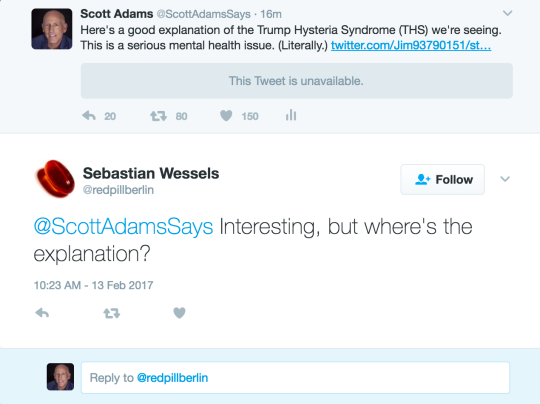Scott Adams's Blog, page 234
February 20, 2017
De-hypnotizing a Climate Science Zombie
I recently stumbled upon a way to nudge anti-Trump zombies off the idea that 97% of climate scientists agree with each other and Trump is on the wrong side. I’m not arguing about the accuracy of the estimate because I have nothing to compare it to. I’m only concerned that people are trusting the fate of the planet to that estimate without knowing how it was derived.
I started with a quote from this article by Lawrence Solomon. He says…
“…a much heralded claim that 97 per cent of scientists believed the planet was overheating came from a 2008 master’s thesis by a student at the University of Illinois who obtained her results by conducting a survey of 10,257 earth scientists, then discarding the views of all but 77 of them. Of those 77 scientists, 75 thought humans contributed to climate change. The ratio 75/77 produced the 97-per-cent figure that global warming activists then touted.”
I assume the student discarded from the study the scientists who were least-involved with climate science. That seems entirely sensible, right? But I don’t know that to be the case.
But then I asked my test subject if it would be important to know the opinions of scientists in general, even if they were not directly involved in climate science. If, for example, 60% of scientists in general were skeptical of climate science, wouldn’t you want to know that? I assume scientists are better-equipped to judge other scientists, even in unrelated fields, at least compared to the public at large.
Next, I asked my test subject if he agreed with the following statement:
"The claim that 97% of scientists agree on climate science MIGHT be true, but I would need to know more about how it was derived to judge its credibility.”
He agreed it was fair.
And keep in mind that the question that generated the 97% figure was limited to whether human activity contributes to warming. Even the critics agree with that statement. Where they differ is on the predictive accuracy of the models.
Summarizing, the problems with the 97% estimate are:
1. Human-caused warming is the part upon which both sides AGREE. Humans “contribute” to warming. The disagreement is on how much, and whether it matters. That wasn’t asked.
2. We don’t know what non-climate-scientists think of the climate models. That would add to our understanding of the topic in a big way.
3. We don’t know how reliable the 97% estimate is because we don’t know enough about the methodology. And it hasn’t been repeated as far as I know.
Try this approach with climate science zombies near you and see if you can nudge them off the 97% figure. Let me know how it goes.
—
You might enjoy my book because 97% of climate scientists agree that it has nothing to do with climate science.

Trump and Sweden
You can see me discussing Trump’s puzzling comments about Sweden in this Youtube video.
I don’t have the technology all worked out yet (it’s a system, not a goal) but you’ll get my point.
This is the direction I’m heading for 2017. Short Youtube videos on recent events.
Twitter shadowbans me so I can’t depend on that platform for the long run. We’ll see how Google and Youtube treat me.
My general YouTube link will be here: bit.ly/2lYiCRo

February 19, 2017
The Paperwork Mistake That Made My Luxury Car Worthless
My BMW X5 SUV is in the shop for its third leak-related problem this year. While it was there, and by coincidence, the dealership’s used car manager called and offered to buy it because there is demand for that model in the used market. I told him it was already at the dealership and he could take a look at it.
The used car manager called me later to tell me my car only has “salvage value.” It turns out that the last two times I took it to Big O for tire repairs they wrote down my mileage incorrectly. One time they recorded it as 30,000 miles. Another time they said 80,000 miles. The actual mileage is around 50,000.
Now here’s the interesting part. That double-paperwork-error by the tire shop made its way to the Internet and the CarFax service that dealers use to know whether cars have had accidents or other issues. The mileage discrepancy automatically puts my car in the “probably turned-back the odometer” category. And that means it has no resale value to dealers or anyone else who checked online.
Apparently I can fix this problem by providing documentation of my correct mileage. I probably don’t have that documentation because the only other people who ever checked my mileage were the dealership that is telling me my car is now officially garbage.
You’ll tell me they just want to buy the car from me for cheap. But they didn’t even offer to buy it. The used car manager just seemed embarrassed by the whole thing. Apparently this isn’t a trick. My car is actually “salvage value” now.
Thanks, Big O Tires. Don’t expect me to come back.

February 17, 2017
Imaginary News
I think we can all agree that there has been plenty of fake news coming from both sides. Fake news is usually intentional, although in some cases it is the result of honest mistakes. But lately we are seeing an entirely new type of untrue news. I call it Imaginary News. Here’s a good example from the Huffington Post.

I watched President Trump’s press conference with the alleged “meltdown,” and all I saw was Trump talking the way he normally talks. The Huffington Post watched and apparently saw some other set of circumstances. That means we have three possibilities to consider:
1. Huffington Post saw the situation accurately while I was hallucinating.
2. My version of events is accurate and Huffington Post hallucinated.
3. Both the Huffington Post and I were hallucinating.
When I was younger, I would have automatically assumed that I was right and the Huffington Post was either intentionally lying or deluded. My more mature understanding of the world is that most people are hallucinating most of the time. We live in our own personal movies. This is a perfect example. Millions of Americans looked at the same press conference and half of us came away thinking we saw an entirely different movie than the other half. Many of us saw Trump talking the way he normally does, and saying the things he normally says. Other people saw a raving lunatic, melting down.
Those are not the same movies.
So how can we know who is hallucinating in this case? The best way to tell is by looking for the trigger for cognitive dissonance. In this case, the trigger is clear. Trump’s unexpected win forced the Huffington Post to rewrite their mental movies from one in which they were extra-clever writers to one in which they were the dumbest political observers in the entire solar system.
You might recall that the Huffington Post made a big deal of refusing to cover Trump on their political pages when he first announced his candidacy. They only carried him on their entertainment pages because they were so smart they knew he could not win.
Then he won.
When reality violates your ego that rudely, you either have to rewrite the movie in your head to recast yourself as an idiot, or you rewrite the movie to make yourself the hero who could see what others missed. Apparently the Huffington Post chose to rewrite their movie so Trump is a deranged monster, just like they warned us. That’s what they see. This isn’t an example of so-called “fake” news as we generally understand it. This is literally imaginary news. I believe the Huffington Post’s description of the press conference is literally what they saw. If you gave them lie detector tests, they would swear they saw a meltdown, and the lie detector would say they were telling the truth.
There are two clues that the Huffington Post is hallucinating and I’m not. The first clue is that they have a trigger and I don’t. Reality violated their egos, whereas I was predicting a Trump win all along. My world has been consistent with my ego. No trigger. All I have is a warm feeling of rightness.
The second clue is that the Huffington Post is seeing something that half the country doesn’t see. As a general rule, the person who sees the elephant in the room is the one hallucinating, not the one who can’t see the elephant. The Huffington Post is literally seeing something that is invisible to me and other observers. We see a President Trump talking the way he normally talks. They see a 77-minute meltdown.
I’m writing more on this topic in my upcoming book.
—
You might want to read my existing book because the new one will be out in October and you’ll want to read that one second.

February 16, 2017
How to Evaluate a President
Steve Jobs. Bill Gates. Mark Zuckerberg. Richard Branson. What do they all have in common, aside from wealth?
They all succeeded without the right kind of prior experience. Apparently they knew how to figure out what they needed once they started. I’ll bet they are all systems-thinkers, not goal-thinkers.
If you see the world in terms of goals, you might think President Trump has failed at every important goal so far. He didn’t get what he wanted on immigration. He hasn’t gotten his Supreme Court nomination confirmed. He hasn’t replaced Obamacare. He hasn’t defeated ISIS. He hasn’t done a lot of things he said he would do. He even had to fire General Flynn. President Trump is a big ol’ failure when it comes to goals.
Maybe that’s because Trump just started on the job. Success generally comes after you start. If you think success comes before you start, the world probably looks confusing to you.
But in any case, as I often say, goals are for losers. Systems are better. As I describe in my book, a good system is something you do every day that leads you to better outcomes, not specific objectives. For example, going to college is a good system even if you don’t know what job you might later want. Any time you learn something valuable, that’s a system. Networking with important people is a system. And so on.
Trump seems to be a systems thinker. I doubt he knew he would jump from real estate developer, to author, to reality TV star, to president. At least not in that order. Instead, he systematically accumulated money, persuasion skills, and personal connections until he had lots of options. Being president was one of them.
Now the world watches as an entrepreneurial systems-thinker with no government experience takes over the White House and tries to learn on the job. How did you expect that to go?
I expected some broken dishes, some firings, some chaos, and some rookie mistakes. We got all of that. But I also expect a systems-thinker to tame the chaos over time as he learns on the job. For example, the leaks will stop as soon as Trump fires the right people. He’ll figure out which meetings he can skip. He’ll know who to trust. He’ll learn where all the buttons and levers are. It’s a process.
If you are comparing the incoming Trump administration to the smooth transfer of power that defines our modern history, that’s an irrational comparison. If the country wanted a smooth ride it would have elected Hillary Clinton. Instead, voters opted to “drain the swamp.“ And you can’t drain the swamp without angering the alligators and getting some swamp water on your pants. That’s what we’re watching now.
My liberal friends are gleefully scouring the semi-fake news and sending me articles that show Trump is “incompetent.” That’s the new narrative on the left. The Hitler illusion is starting to fade because Trump refuses to build concentration camps as his critics hallucinated he would. And Israel likes Trump, which is making the Hitler illusion harder to maintain. So the critics are evolving their main line of attack from Hitler to “incompetent,” with a dash of “chaos.” You’ll see those two words all over the Opposition Media’s coverage. It isn’t a coincidence.
Persuasion-wise, focusing on incompetence and chaos is a strong play by the anti-Trumpers. One would expect the new Trump administration to have lots of growing pains. That means the Opposition Media will have plenty of fodder that they can frame as incompetence and chaos. Confirmation bias will make it all seem to fit the narrative. This is the same persuasion play that Trump used when he assigned to his opponents nicknames such as Lyin’ Ted and Crooked Hillary. He depended on future news cycles to serve up lots of confirmation bias to make his labels more credible over time. Trump’s opposition is running the same persuasion play on him. Now everything he does will be seen through their frame of “incompetence” and “chaos.” Even if it isn’t. That is strong persuasion.
If you step out of the Opposition Media’s framing of Trump, another frame that fits the data is that he’s learning on the job, just like he learned every other field that he entered and eventually mastered. I don’t know what you expected when Trump went to Washington, but it isn’t too different from what I imagined. I assumed there would be broken dishes. And I assumed it would take him months to get his systems in place.
When I worked in corporate America, I was usually involved in setting goals for the department. When we didn’t meet those goals, I always pointed out that the problem could be on either end. Either the goals were unrealistic or the performance was bad. Both explanations fits the data. Likewise, Trump’s first few weeks do look exactly like “incompetence” and “chaos” if you are primed to see it that way. But they also look like a systems-thinker simultaneously draining the swamp and learning on the job.
Po-tay-to, po-tah-to.

February 15, 2017
How to Persuade the Other Party
An interesting article in The Atlantic talks about studies showing that liberals think in terms of fairness while conservatives think in terms of morality. So if you want to persuade someone on the other team, you need to speak in their language. We almost never do that. That’s why you rarely see people change their opinions.
As I often say, fairness is a concept invented so children and idiots can participate in debates. Fairness is a subjective illusion. It isn’t a rule of physics, and it isn’t an objective quality of the universe. We just think it is.
On the conservative side, morality is usually seen as coming from God. I’m not a believer, so I see morality as a set of rationalizations for our biological impulses. Luckily, we evolved with some instincts for taking care of each other.
The Persuasion Filter says that both fairness and morality are different forms of magical thinking. And according to that filter on reality, you can’t change the mind of a liberal or a conservative with your logic and your reason. Magical thinking is immune to both.
If your aim is to persuade, you have to speak the language of the other. Talking about fairness to a conservative, or morality to a liberal, fails at the starting gate. The other side just can’t hear what you are saying.
Let me run through some examples. These haven’t been A/B tested, so don’t assume they are persuasive. But they do follow proper form.
Bad argument from a conservative to a liberal:
Abortion is wrong because it takes a human life. (morality)
Good argument from a conservative to a liberal:
Is it fair that you got to grow from a fetus to a full life while so many others do not? Who gets to choose who lives and who dies? (fairness)
I’m not saying the “good” argument would necessarily work. I’m just saying it follows form.
Flipping it around…
Bad argument from a liberal to a conservative:
Climate change is enriching the energy companies at the expense of everyone else. (fairness)
Good argument from a liberal to a conservative:
God created this world and asked us to look after it. We will be judged in the afterlife if we accidentally ruin it for the sake of temporary profit. (morality)
I realize my examples are not strong, but they help explain the concept. The only way you can judge the power of the arguments is by testing them.
Logic, morality, and fairness are three different approaches to persuasion. But there is a fourth way to persuade that involves ignoring both fairness and morality without giving up logic. You can take most debates out of the weeds of fairness and morality to what I call the High Ground, where everyone already agrees.
For example, on the topic of abortion rights there is no way to reach agreement if we are squabbling about morality and fairness. But we might agree that the Federal government should stay out of the abortion business – both pro or con – and leave those types of decisions to the individual and the states.
In the olden days of Roe Vs. Wade, states could ban abortion and get away with it. In 2017 it would be economic suicide. Big employers would stay away because it would be hard to attract talent. Tourists would stay away in protest. Social media would turn the state into a wasteland. No governor can survive a drop in employment that is both state-specific and caused by government action.
Liberals can argue that it is only fair for women to have control over their own bodies. Conservatives can argue that morality means protecting every “life” as they define it. There is no room for compromise with that framing. But both sides might agree on three High Ground concepts:
1. The Federal government (and their Supreme Court puppets) should get out of the business of deciding on women’s reproductive rights. It is neither fair nor moral for them to be involved.
2. It would be economic suicide for a state to ban abortion in 2017.
3. The question of who pays for what is a separate issue.
For new readers of this blog, my view on abortion is that the most credible laws in that area are the ones that have the support of the most women. I choose to delegate my opinion on this topic to women because they have the most skin in the game and I have no special insight to improve the quality of the decisions. I also respect the principle that the people who contribute the most should get some extra rights. (The question of who pays for what is separate.)
—
If you are waiting for your kids to be dropped off by the school bus, you might love using the WhenHub app that my startup makes because you’ll know exactly where they are. That is both fair and moral. And logical.



February 13, 2017
Manage Your Energy, Not Your Time
I put this post over on WhenHub because it fit better there. See it at: http://bit.ly/2lcPbNi

Manager Your Energy, Not Your Time
I put this post over on WhenHub because it fit better there. See it at: http://bit.ly/2lcPbNi

Freedom of Speech is Now Largely an Illusion
Here’s a fresh example (today) of how Twitter throttles back my free speech when it doesn’t fit their political views. This only happens for Trump-related content, as far as I can tell. I haven’t seen an exception yet. Notice the referenced tweet shows as “unavailable” but it actually is available when users click the link. Twitter does this trick so my followers will think the link is gone and they won’t bother to click. This Twitter censorship method is well-documented by others.

The clever thing about Twitter’s approach is that they randomize it so everyone sees my content sometimes, but no one sees the good stuff all of the time. That creates the illusion that it might be a fluke, a temporary bug, or just a perceptual thing. Best of all, it makes people like me look like conspiracy nuts. This is brilliant technique for mind control. It took me about a year to see this as a real thing. I thought everyone that was yapping about it was in deep conspiracy theory mode too. Most of you reading this post will think the same about me.
And you might be right, which is even cooler. As you know, the only person who can’t see the cognitive dissonance is the one in it. So I can never rule out the possibility that the problem is on my end.
I won’t ask you to believe me about Twitter’s backdoor assault on the First Amendment. That would be a waste of energy. Just file it away in your brain and remember that I warned you. Twitter’s business is about to fall apart and I expect that you’ll see this story emerge from whistleblowers.
I’m trying to get my channel on YouTube running smoothly for after Twitter’s collapse. I’m still having massive and unpredictable hardware/software issues. You’ll see my A/B testing over at this link. Keep it handy in case I suddenly disappear from Twitter.
—
See the Grammy winners in a WhenCast.

Two Monday Mind-blowers
First we have a link to an example of how two movies can play on one screen (in our minds) at the same time. This is how hypnotists see the world. It is rare to see an example this clean.
If you like or hate science you will love this real life example of cognitive dissonance @ScottAdamsSayshttps://t.co/8l8xCkrKNv
— Andrew Fisher (@fortyseventogo) February 13, 2017
Next, a link to an article that gives you a preview of how machines are learning to chemically program humans. The machines are learning how to adjust our rewards to maximize addiction. There is no logical end to this. Once machines learn hypnosis (and they can), we work for them.
Dopamine Labs slings tools to boost and reduce app addiction https://t.co/3dgcHouf8O by @jshieber
— TechCrunch (@TechCrunch) February 13, 2017
—
Did you see the Grammy’s? My startup was running a continuously-updated WhenCast of the winners that night. You can see them here.


Scott Adams's Blog
- Scott Adams's profile
- 1259 followers



